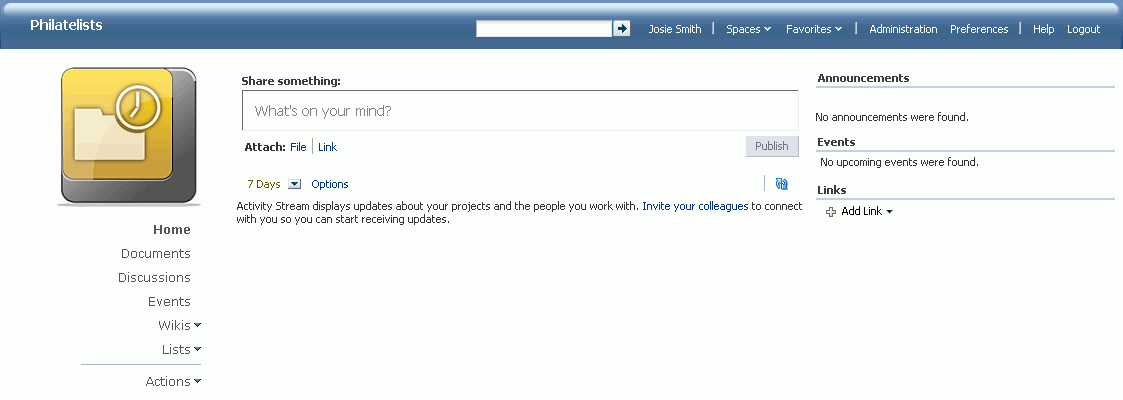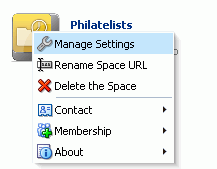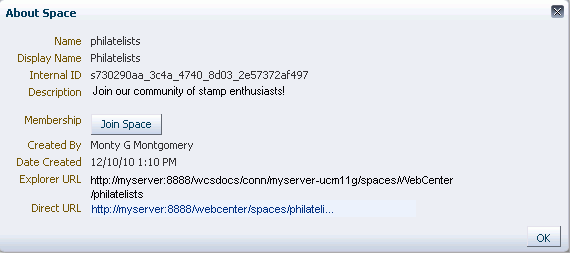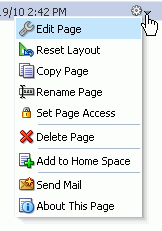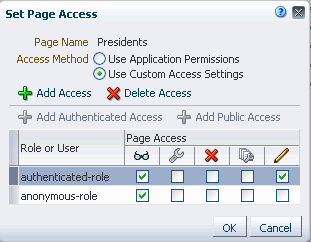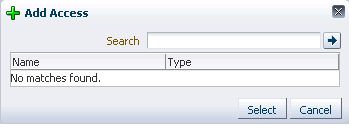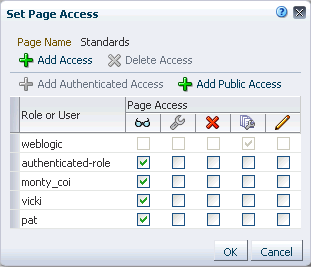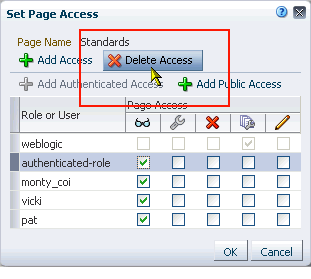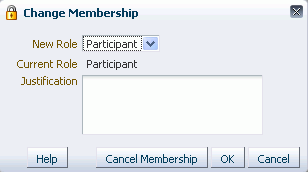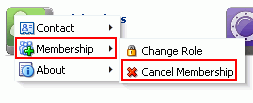49 Understanding Space Basics
WebCenter Portal: Spaces supports the formation and collaboration of project teams and communities of interest through spaces. A space provides a dedicated and readily accessible area for relevant services, pages, and content and supports the inclusion of specified members, each of whom have defined roles associated with permissions in the space. Spaces bring people together in a virtual environment for ongoing interaction and information sharing—in essence, spaces enable the formation and support of social networks.
This chapter provides information about working with spaces. It contains the following sections:
-
Section 49.3, "Interacting with Spaces Before Logging In (Public User)"
-
Section 49.10, "Showing or Hiding Pages in Your View of a Space"
-
Section 49.14, "Removing All of Your User Customizations from a Page"
-
Section 49.17, "Controlling User Access to Your Space Pages"
-
Section 49.19, "Exposing a Space Page in Your View of the Home Space"
-
Section 49.21, "Viewing Information About a Page in a Space"
This chapter is intended for Spaces users who want to learn more about working with spaces in a Spaces application.
49.1 What You Should Know About Spaces
Within any company, large groups or departments frequently must break into smaller groups to focus on a particular goal, project, or even topic. Or, outside of a professional environment, communities of people with a common interest may wish to share and post information to foster the community. To help these groups organize themselves, Spaces provides the notion of spaces, which bring content together through a single access point, accessible through the Spaces application or by direct URL, to help groups of people share information and interact in a collaborative social network. For example:
-
Internal departments within your company that must share common information, such as HR, Sales, and so on.
-
Software projects that must bring together the efforts and input of Development, Quality Assurance, Product Management, Documentation, and Curriculum Development.
-
Special interest groups that share a common interest in a particular topic.
Many features and tools to facilitate teamwork are built into the space framework, instantly allowing space members to share documents, discuss issues, schedule meetings, exchange messages, create lists, and much more. Spaces can be monitored through RSS feeds, which you can add to your personalized view of the Home space or view in any external RSS reader.
Spaces provides templates for creating spaces that support different types of endeavors. The flexibility of space templates means that every space can have a different look and feel. You can use an out-of-the-box template, or create your own custom templates using an existing space as the basis for the template. For information about space templates, see Chapter 50, "Working with Space Templates." After creation, Spaces can be completely customized, including the navigation controls, the color scheme, and the look and feel of any task flow or portlet, all from within the browser.
When you create a space, you are the space moderator. As the moderator, you manage the space and establish the rules for membership to a space (see Section 52.1, "Setting Up the Membership Policy for a Space"). When a new space is created, Spaces creates default space roles with default permissions. The space moderator can assign space members to these roles and modify the default permissions as required, or create new custom roles (see Section 52.2, "Managing Roles and Permissions for a Space" and Section 52.3, "Managing Members and Assigning Roles").
Any space can be parent to one or more subspaces. This allows you to develop a space hierarchy. For more information, see Chapter 54, "Working with a Space Hierarchy."
49.2 What Does a Space Look Like?
A newly created space may look similar to Figure 49-1 (side navigation) or Figure 49-1 (top tabbed navigation). It is important to realize, however, that your Spaces administrator or the space moderator has most likely created and applied a custom page template to expose or hide tabs, features, and display a unique look and feel for your organization. A new space that you create may look nothing like these examples.
Each page in a space provides access to related information. In the example space above, the Home page summarizes important information about the Philatelists club, the Documents page lists folders and files associated with the Philatelists club, the Discussions page provides a view of ongoing discussions with discussion forum management features, and so on. The space moderator (or any space member assigned the Moderator role or a custom role that includes the Spaces-Manage Configuration permission) uses the pages available through the space administration settings to build and manage the space, expanding and customizing it as needs change and grow. For information about administration tasks in a space, see Chapter 50, "Working with Space Templates," Chapter 51, "Managing a Space," Chapter 52, "Managing Space Members and Roles." For information about adminstering all spaces and space templates as the Spaces application administrator, see Chapter 53, "Administering Spaces and Templates."
49.3 Interacting with Spaces Before Logging In (Public User)
Public spaces are available to anyone with Internet access, without logging in to Spaces, allowing a space to be shared with non-members and people outside of the Spaces community.
Public users who are not registered Spaces users can access public spaces in two ways:
-
Directly, using the space URL provided to them.
-
From the Spaces Welcome page, if their installation is configured to display this page (Figure 49-3).
Figure 49-3 Public Spaces Link on Welcome Page
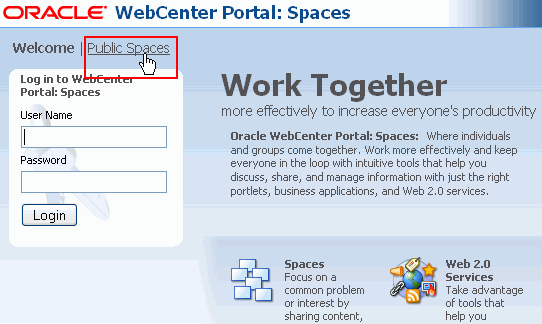
Description of "Figure 49-3 Public Spaces Link on Welcome Page"
The Spaces administrator controls what a public user can see or do at the application level. For more information, see Section 21.2.4, "Granting Permissions to the Public-User."
When a space is made public, the Public-User role in the space is automatically granted View Pages and Content permission in the space, which allows public users to view pages, lists, events, links and notes. To view announcements, discussions, and documents, the space moderator must explicitly grant these permissions, as described in Section 51.14.5, "Granting Public Access to a Space." The public permissions granted by the space moderator override the public permissions set by the administrator at the application level.
49.4 Viewing Available Spaces
You can participate in multiple spaces and manage your space memberships through the Spaces Switcher menu, a Spaces Browser task flow, or the Spaces page, which displays all the spaces that are available to you.
To display a list of available spaces:
-
In the Home space, click Spaces, then choose Browse Spaces in the Spaces Switcher menu.
Tip:
Your Spaces application may provide other ways to access the spaces available to you. See Section 29.3.1, "Opening Spaces."
-
On the Spaces page, from the Show list, choose:
-
All Spaces (Figure 49-4) to show all spaces that are available to you, both public and private. Spaces defined as hidden when created are not shown.
-
Joined by Me to display spaces of which you are a member.
-
Moderated by Me to display spaces for which you have moderator privileges.
-
Closed Spaces to display spaces available to you that have been closed by the space moderator (see Section 51.4.5, "Closing or Reactivating a Space"). The content of a closed space remains accessible and searchable to those who still want to reference it and space members can continue working in the space either by selecting Closed Spaces as described here, or by direct URL (
http://host:port/webcenter/spaces/space name).
-
-
To list one or more specific spaces, enter a full or partial search term in the Filter field, then click the Filter icon to refresh the list with all spaces for which a match is found in the Display Name, Description, or Search Keywords (specified on the General page in the administration settings for the space).
-
To clear the current search string and display all spaces, click the Clear Filter icon.
-
To refresh the list of spaces, first ensure that any prior search is cleared (click the Clear Filter icon), then click the Refresh icon.
-
To go to the Home page of a space, click the space name or icon.
-
To display a menu of actions available on the space, right-click a space icon or name to explore the actions that are available to you, depending on your permissions in the space (Figure 49-5):
Note:
Space administration selections (Manage Settings, Rename Space URL, and Delete the Space) are shown only if you are the space moderator or have
Manage Configurationpermission on the space.Choose:
-
Manage Settings to open the space administration settings pages. See Chapter 51, "Managing a Space."
-
Rename Space URL to change a space URL that other people use to navigate to the space. See Section 51.14.2, "Changing a Space URL."
-
Delete the Space to delete the space. See Section 51.17, "Deleting a Space."
-
Contact menu:
-
Subscribe to open the Subscribe dialog, where you can select notification messages that you want to receive whenever the listed actions occur within the scope of the space. See Section 36.3.2, "Setting Space-Level Subscriptions."
-
Send Mail to Members and Send Mail to Moderators. See Section 51.15, "Sending Mail to Space Members or Moderators."
-
-
Membership menu:
-
Change Role to change your role in the space. See Section 49.22, "Changing Your Role in a Space"
-
Cancel Membership to cancel your membership in the space. See Section 49.23, "Cancelling Space Membership".
-
-
About menu:
-
About this Space to view information about the space. See Section 49.5, "Viewing Information About a Space."
-
Similar Spaces to open the Similar Spaces dialog, which provides suggestions of other spaces similar to the current space. A space is considered similar to another space if the same people perform similar actions in it, especially if they edit the content. Similar Spaces is provided by the Activity Graph service. For more information, see Chapter 58, "Working with the Activity Graph Service."
-
Share Link to share the URL link to the space with others. See Section 51.14.1, "Publishing the Link to a Space."
-
-
49.5 Viewing Information About a Space
To view information about a space:
-
In the Home space, click Spaces, then choose Browse Spaces in the Spaces Switcher menu.
Tip:
Your Spaces application may provide other ways to access the Spaces available to you. See Section 29.3.1, "Opening Spaces."
-
On the Spaces page, locate the space that you want to learn about (see Section 49.4, "Viewing Available Spaces"), then right-click the space icon or name, and choose About, then About this Space (Figure 49-6).
The About Space dialog opens (Figure 49-7).
-
Explore the information in the About Space dialog:
-
Name: Internal name of the space displayed in the space URL. To change the internal space name, see Section 51.14.2, "Changing a Space URL." Caution: When you change the internal space name, bookmarks to the space must be updated as they will no longer work.
-
Display Name: Display name of the space. This name displays at the top of the space and other places where spaces are available for selection, such as the Spaces Switcher menu and the Spaces page. To change the space display name, see Section 51.4.1, "Renaming a Space." Changing the display name does not impact the URL that people use to navigate to the space.
-
Internal ID: ID of the space, which other applications may use to reference this space.
-
Description: A description of the space, specified when creating the space or in the space administration settings, as described in Section 51.4.2, "Modifying the Description or Keywords for a Space."
-
Membership: Your role in the space. If you are not a member of this space and the space allows self-service membership, a Join Space button displays here. See Section 49.7.1, "Joining a Space (Registered Spaces User)."
-
Created By: User name of the space creator.
-
Date Created: Date and time that the space was created.
-
Explorer URL: URL used expose the folders and files in a space using Windows Explorer. See Section 46.4.1, "Adding a Space as a Network Place."
-
Direct URL: URL that provides direct access to the space.
-
49.6 Searching for a Space
To search for a space by a string in the Name or Description:
-
On the Spaces page (see Section 49.4, "Viewing Available Spaces"), enter a search string in the Filter field.
-
Click the Filter icon (Figure 49-8).
The Spaces page displays spaces where the search string is found in the Name or Description.
-
To clear the current search string and display all spaces, click the Clear Filter icon (Figure 49-8).
49.7 Joining a Space
To become a member of a space, you can join the space. You may be registered with Spaces, or you may be a public user. If a space allows self-service membership (see Section 52.1.1, "Managing Self-Service Membership for a Space"), you can request membership to the space. Or, you may receive an invitation to join a space.
This section includes the following subsections:
49.7.1 Joining a Space (Registered Spaces User)
To become a member of a space, you can join the space. If a space is configured to allow self-service membership, you can request membership to the space. Or, you may receive an invitation to join a space.
Some membership requests require approval from the space moderator so you may not gain access immediately. You will receive a Worklist notification when your membership is approved.
To join a space:
-
In the Home space, click Spaces, then choose Browse Spaces in the Spaces Switcher menu.
Tip:
Your Spaces application may provide other ways to access the Spaces available to you. See Section 29.3.1, "Opening Spaces."
-
On the Spaces page, from the Show menu, choose All Spaces.
-
To join a space, you may have several options available to you, depending on the page template in use. For example, you may be able to simply click a space to open the Request Membership dialog.
A generally available method to join a space is through the About Space dialog: right-click the space icon or name, and choose About, then About this Space (Figure 49-10).
-
In the About Space dialog, next to Membership, click Join Space (Figure 49-11).
Note:
Join Space is active only if the space allows self-service membership (see Section 52.1.1, "Managing Self-Service Membership for a Space"). If Join Space is disabled, contact the space moderator directly to request membership.
A space membership request page similar to Figure 49-12 opens, showing the default Request Membership page. Because the space moderator may customize this page, the page and roles you see may be different to the example shown here.
-
Select the type of Role you want to play in this space.
Note:
Out-of-the-box space roles include
Viewer,Participant, andModerator, but a subset of these or other custom roles names may display, depending on what roles the space moderator has defined for the space. -
(Optional) In the Purpose field, enter an explanation of why you need access to the space with the role you have requested.
-
Click Request Membership.
You should see a confirmation message similar to Figure 49-13, depending on whether or not the selected role requires moderator approval.
-
Click OK.
-
On the Spaces page, click the Refresh icon to confirm your new membership status.
Note:
If membership requests require approval, you do not gain access immediately. Check back later or monitor your Worklist—you will receive notification as soon as your membership is approved.
49.7.2 Joining a Space (Unregistered Spaces User)
If you are not a registered Spaces user, you can still view public Spaces, but you cannot join a space unless you receive a mail message from the space moderator inviting you to join a space (see Section 52.3.4.5, "Inviting a Non-Registered User"). If you want to join a space, you must become a registered Spaces user.
Some membership requests require approval from the space moderator so you may not gain access immediately. You will receive a Worklist notification when your membership is approved.
-
In the mail message you receive inviting you to join a space, click the Register Yourself link included in the invitation mail to open the Self-Registration page, similar to Figure 49-14. Because the space moderator may customize this page, the page you see may be different to the example shown here.
Note:
For the Self-Registration page to display, the membership options for the space administration settings must have either of the following enabled:
-
Allow Self-Service Membership or Self-Service Membership Change (All Roles Available)
-
Allow Self-Service Membership or Self-Service Membership Change (Selected Roles Available)
For more information, see Section 52.1.1, "Managing Self-Service Membership for a Space."
-
-
Choose a suitable User Name. The user name restrictions depend on the underlying identity store that is configured with Spaces.
Click Check User Name Available to determine whether a Spaces user is registered with that name. Click OK to dismiss the confirmation message and, if necessary, enter a different name.
-
Enter a suitable Password, and then Re-enter Password for verification. The password restrictions depend on the underlying identity store that is configured with Spaces.
-
Enter your First Name and Last Name, and an Email Address.
-
Click Register.
Once your User Name and Password are registered with Spaces, the space to which you were invited opens.
49.8 Searching in a Space
Spaces includes the Search field at the top of the application for global (that is, application-wide) searches. To perform searches limited to a single space, the space administrator must create a new Resource Catalog, add the Search task flow from the library to the Catalog, and then assign this Catalog to the space. The Search task flow is not available in the default Resource Catalog. For more information, see Section 56.4, "Narrowing the Scope of Search."
To search for individual pages in a space, see Section 51.7.4, "Searching for Pages in a Space."
49.9 Viewing Pages in a Space
In a space, members have access to system pages (see Table 7-2, "Seeded System Pages") and member-created pages. The content on a space page is typically targeted to a particular audience or objective.
The way that you access the pages of a space depends on the page template that is defined for the space. At the application level, the Spaces administrator can define the page template to be used for all new spaces, but anyone with Manage Configuration permission on a space can modify the page template of an individual space (see Section 51.4.9, "Changing the Page Template for a Space").
Note:
If you view a page at the same time that another user is editing the page, you may not immediately see the results of changes made by the other user in your session. To reliably see any changes, you must view the page after the other user has saved their edits.
49.10 Showing or Hiding Pages in Your View of a Space
To show or hide pages in your personal view of a space:
-
In the space, display the Personalize Pages page.
Tip:
The way you access this page depends on the page template in use. For example, in a side navigation template, you may access it through a Manage menu.
-
On the Personalize Pages page, select or clear the Show Page checkbox for the pages you want to show or hide.
49.11 Creating Your Own Page in a Space
If you are granted permission to create pages (see Table 52-2, "Space Permissions - Simple Permission Model"), you can add your own pages to a space.
The pages you create can be viewed by you and anyone to whom you grant access (see Section 49.17, "Controlling User Access to Your Space Pages").
To create your own page in a space:
-
In the space, display the Personalize Pages page.
Tip:
The way you access this page depends on the page template in use. For example, in a side navigation template, you may access it through a Manage menu.
-
On the Personalize Pages page, click Create Page (Figure 49-15)
-
In the Create Page dialog, specify the name and style for the new page.
For detailed information about each page style, see Section 15.1, "What You Should Know About Page Styles."
The new space page opens in edit mode (Composer), where you can add content, then Save and Close the page.
See Also:
For information about adding content to a space page, see:
49.12 Managing Your Pages in a Space
Space moderators and members with page management permissions (see Table 52-2, "Space Permissions - Simple Permission Model") can manage space pages at the application level on the Pages page in the administration settings for the space, which configures the default page settings for all members of the space. For more information, see Section 51.7, "Creating and Managing Space Pages."
As a space member, you can manage your pages in the space. The actions available to you depend on the permissions you are granted in the space or on a particular page. If you have permissions to delete, edit, or set access privileges to a page, performing these actions affect all members in the space as these actions alter the page itself. Actions such as reordering or showing and hiding pages is reflected in your "personal" view of the space only.
To manage your pages in a space:
-
In the space, display the Personalize Pages page (Figure 49-16)
Tip:
The way you access this page depends on the page template in use. For example, in a side navigation template, you may access it through a Manage menu.
-
On the Personalize Pages page, perform any of the actions available to you on the the Actions menu for a specific page (Figure 49-17):
-
Edit Page. Edit a page that you own or have privileges to edit. See Section 49.13, "Editing Your Pages in a Space."
-
Reset Layout. Remove all of your user customizations from a selected page. This action removes such personal changes as rearrangement, resizing, or collapsing of task flows in only your view of the page. See Section 49.14, "Removing All of Your User Customizations from a Page."
-
Copy Page. Make a personal copy of a page. See Section 49.15, "Copying a Page to Your View of a Space."
-
Rename Page. Rename a page that you own or have privileges to manage. See Section 49.16, "Renaming Your Pages in a Space."
-
Set Page Access. Add or remove access to a page by user role. See Section 49.17, "Controlling User Access to Your Space Pages."
-
Delete Page. Delete a page that you own or have privileges to manage. See Section 49.18, "Deleting Your Pages in a Space."
-
Add to Home Space. Add a page to your personal view of the Home space. See Section 49.19, "Exposing a Space Page in Your View of the Home Space."
-
Send Mail. Send a link to a page that you own or have privileges to manage. See Section 49.20, "Sending a Link to a Page in a Space."
-
About This Page. View information about a page. See Section 49.21, "Viewing Information About a Page in a Space."
-
49.13 Editing Your Pages in a Space
If you own or have write permissions on a page, you can edit the page. However, you should be aware that edit actions affect all members in the space as these actions alter the page itself, not only your personalized view.
To edit a page that you own or have permission to edit:
-
In the space, display the Personalize Pages page.
Tip:
The way you access this page depends on the page template in use. For example, in a side navigation template, you may access it through a Manage menu.
You can also navigate to this page using the direct URL provided in Section A.4, "User Interface URLs for Space Pages."
-
On the Personalize Pages page, click the Actions icon for the page, and choose Edit Page to display the page in edit mode (Composer).
See Also:
For information about adding content to a space page, see:
49.14 Removing All of Your User Customizations from a Page
To remove all of your user customizations, such as rearrangement, resizing, or collapsing of task flows in only your view of a page:
-
In the space, display the Personalize Pages page.
Tip:
The way you access this page depends on the page template in use. For example, in a side navigation template, you may access it through a Manage menu.
You can also navigate to this page using the direct URL provided in Section A.4, "User Interface URLs for Space Pages."
-
On the Personalize Pages page, click the Actions icon for the page, and choose Reset Layout to open the Reset Layout dialog.
-
To confirm your intent to remove all of your user customization from the page, click Reset.
49.15 Copying a Page to Your View of a Space
To copy a page in a space for your own purposes:
-
In the space, display the Personalize Pages page.
Tip:
The way you access this page depends on the page template in use. For example, in a side navigation template, you may access it through a Manage menu.
You can also navigate to this page using the direct URL provided in Section A.4, "User Interface URLs for Space Pages."
-
On the Personalize Pages page, click the Actions icon for the page, and choose Copy Page to open the Copy Page dialog.
The new page is available only to you, unless you make it available to others (see Section 49.17, "Controlling User Access to Your Space Pages."
49.16 Renaming Your Pages in a Space
If you own or have privileges to manage a page, you can rename the page. However, you should be aware that renaming a page affects all members in the space as this action alters the page itself, not only your personalized view.
When you rename a page, keep in mind that any pretty URLs that use the old name will be broken. Also note that system pages, such as the Announcements, Lists, and Events pages, do not provide the option of being renamed.
See Also:
For information about pretty URLs, see Appendix A, "Spaces User Interface URLs."
To rename a page that you own or have privileges to manage:
-
In the space, display the Personalize Pages page.
Tip:
The way you access this page depends on the page template in use. For example, in a side navigation template, you may access it through a Manage menu.
You can also navigate to this page using the direct URL provided in Section A.4, "User Interface URLs for Space Pages."
-
On the Personalize Pages page, click the Actions icon for the page, and choose Rename Page to open the Rename Page dialog.
-
Enter a new name for the page, and click the Save icon.
49.17 Controlling User Access to Your Space Pages
By default, the pages you create in a space are accessible only to you and other space members assigned the Moderator role or a custom role that includes the Spaces-Manage Configuration permission. You can use page access settings to enable other members to view and work with your pages and to remove that access.
When you grant access to one of your own space pages to another user, the other user must deliberately show the page in his or her view. The user must take this step for each session because shared pages are not automatically shown on login.
See Also:
For information about how to show a hidden page, see Section 49.10, "Showing or Hiding Pages in Your View of a Space."
To control the access for other space members to your pages:
-
In the space, display the Personalize Pages page.
Tip:
The way you access this page depends on the page template in use. For example, in a side navigation template, you may access it through a Manage menu.
You can also navigate to this page using the direct URL provided in Section A.4, "User Interface URLs for Space Pages."
-
On the Personalize Pages page, click the Actions icon for the page, and choose Set Page Access to open the Set Page Access dialog (Figure 49-18).
-
Select the Access Method:
-
To specify that the page should inherit access settings from the permissions established for the space, select Use Application Permissions, then click OK to save your changes and exit the dialog. For information about setting global space permissions, see Section 52.2, "Managing Roles and Permissions for a Space."
-
To set custom access on the current page, select Use Custom Access Settings, and continue with the next steps.
-
-
To grant page access permissions to all authenticated users (that is, to users who are logged in to Spaces), click Add Authenticated Access.
The role
authenticated-roleis added under Role or User with default Read access to the page. -
To grant page access permissions to all public users, that is, users who have not logged in to Spaces, click Add Public Access.
The role
anonymous-roleis added under Role or User with default Read access to the page (Figure 49-19). -
To grant page access permissions to selected users, groups, and application roles, click Add Access to open the Add Access dialog (Figure 49-20).
-
In the Search field, enter a search term or the name of the user, group, or role for whom you want to enable access, and click the Search icon. For tips on searching for a user or group in the identity store, see Section 52.3.4.1, "Searching for a User or Group in the Identity Store."
Note:
In the Add Access dialog, you can add the default roles
Moderator,Participant, andViewer, and any custom roles that have been created for the space.For more information about space roles, see Section 52.2, "Managing Roles and Permissions for a Space"
-
Select a user, group, or role by clicking in its row.
Note:
When you select a user name, the permissions you set are granted to that specific user. When you select a group or application role, the permissions you set are granted to all users who are members of that group or who are assigned that role.
To make multiple selections:
-
Ctrl-Click to select multiple rows.
-
Shift-Click to select a range of rows.
-
-
Click Select to close the Add Access dialog, and populate the Set Page Access dialog with the selected users, group, or roles (Figure 49-21).
-
In the Set Page Access dialog, set the Page Access permissions as desired for each user, group, or role (Table 49-1).
Note:
If you set page access permissions for the
anonymous-role(public users), the space must also be made public to allow this page to be seen by public users. See Section 51.14.5, "Granting Public Access to a Space."Table 49-1 Page Access Privileges in the Set Page Access Dialog
Icon Name Description 
View Page
Users can access the page for viewing, but cannot perform any other actions on the page.

Edit Page
Users can edit the page using Composer. This includes adding, rearranging, and deleting content; renaming the page; and changing page properties, such as the page scheme.

Delete Page
Users can delete the page.

Perform All Page Actions
Users can perform all actions on the page.

Personalize Page
Users can rearrange page content and personalize his or her view of task flows, provided the task flow includes personalization settings.
Tip:
By default, all authenticated users and user roles that you add to the Set Page Access dialog are granted page view access. The other access privileges must be explicitly granted.
-
If you wish to delete access to the page for a user role, select the user or role from which to revoke page access, and click Delete Access (Figure 49-22).
-
Click OK to save your changes and close the Set Page Access dialog.
49.18 Deleting Your Pages in a Space
If you own or have manage permissions on a page, you can delete the page. However, you should be aware that deleting a page affects all members, not only your personalized view.
To delete a page that you own or have permission to manage:
-
In the space, display the Personalize Pages page.
Tip:
The way you access this page depends on the page template in use. For example, in a side navigation template, you may access it through a Manage menu.
You can also navigate to this page using the direct URL provided in Section A.4, "User Interface URLs for Space Pages."
-
On the Personalize Pages page, click the Actions icon for the page, and choose Delete Page to display the Delete Page dialog.
-
Confirm deletion of the page, and click Delete.
49.19 Exposing a Space Page in Your View of the Home Space
You can make a space page is available for viewing and revising from within your view of the Home space according to your permissions on the page. The space name is prepended to the page name, so the Sales Results page in the space Finance becomes Finance - Sales Results in your view of the Home space.
Note:
System pages that are exposed in a space, such as Events, Lists, and Announcements, do not provide the option of being exposed in the Home space. For information about System pages, see Section 7.3, "Working with System Pages."
If you delete such a page from your view of the Home space, it remains a part of its original space. In other words, deleting it simply removes it from your view of the Home space; it does not actually delete the page. If the page is deleted from its parent space, it is unavailable in your view of the Home space. To clear it from your view, you must refresh the page list in the Home space's Personalize Pages page.
To add a space page to the list of pages in the Home space, visible only to you in your personalized view of the Home space:
-
In the space, display the Personalize Pages page.
Tip:
The way you access this page depends on the page template in use. For example, in a side navigation template, you may access it through a Manage menu.
You can also navigate to this page using the direct URL provided in Section A.4, "User Interface URLs for Space Pages."
-
On the Personalize Pages page, click the Actions icon for the page, and select Add to Home Space.
When you add a space page to your view of the Home space, the page scope remains that of the space.
49.20 Sending a Link to a Page in a Space
If you own or have manage permissions on a page, you can send other space members a link to the page.
To send mail to other space members populated with a link to a particular page:
-
In the space, display the Personalize Pages page.
Tip:
The way you access this page depends on the page template in use. For example, in a side navigation template, you may access it through a Manage menu.
You can also navigate to this page using the direct URL provided in Section A.4, "User Interface URLs for Space Pages."
-
On the Personalize Pages page, click the Actions icon for the page, and choose Send Mail to open your mail application compose window, showing a URL link to the page.
49.21 Viewing Information About a Page in a Space
To view information about a page that you can view in a space:
-
In the space administration settings, display the Personalize Pages page.
Tip:
The way you access this page depends on the page template in use. For example, in a side navigation template, you may access it through a Manage menu.
You can also navigate to this page using the direct URL provided in Section A.4, "User Interface URLs for Space Pages."
-
On the Personalize Pages page, click the Actions icon for the page, and choose About This Page to open the Page Information dialog, which shows Name, Created By, Date Created, Last Modified, and Direct URL.
49.22 Changing Your Role in a Space
If you are unable to perform all the actions that you would like in your space, you can request a change to your membership role. For example, you might want to participate in an interesting discussion thread or raise a new issue but in your current role you are only allowed to view ongoing discussions.
Role change requests may or may not require approval, depending on how the space moderator has defined membership changes for a particular role (see Section 52.1.1, "Managing Self-Service Membership for a Space"). You will receive a Worklist notification when your new role is approved.
To change your space role:
-
In the Home space, click Spaces, then choose Browse Spaces in the Spaces Switcher menu.
Tip:
Your Spaces application may provide other ways to access the Spaces available to you. See Section 29.3.1, "Opening Spaces."
-
On the Spaces page, locate the space in which you want to change your role (see Section 49.4, "Viewing Available Spaces"), then right-click the space icon or name, and choose Membership, then Change Role (Figure 49-23).
-
In the Change Membership dialog (Figure 49-24), choose your preferred role from the New Role list.
Note:
The New Role list is active only if the space allows self-service membership changes (see Section 52.1.1, "Managing Self-Service Membership for a Space"). If New Role selections are disabled, contact the space moderator directly to request a member role change.
If you wish to cancel your membership in the space, click Cancel Membership.
The space moderator controls the list of roles displayed here. Out-of-the-box space roles include
Viewer,Participant, andModeratorbut a subset of these or other custom roles may display. For more information, see Section 52.1.1, "Managing Self-Service Membership for a Space" -
Click OK.
A confirmation message displays whether or not the selected role change requires approval.
-
Click OK to acknowledge the confirmation message.
-
On the Spaces page, click the Refresh icon to confirm your membership status has changed for the space.
Note:
Your new role is not effective immediately when membership change requests require approval. Check back later or monitor your Worklist; your new role will be effective as soon as the space moderator approves it.
49.23 Cancelling Space Membership
When you no longer want or need membership in a space, you can cancel your membership.
Some cancellation requests require approval from the space moderator so you may not be removed from the space immediately (see Section 52.1.1, "Managing Self-Service Membership for a Space"). You will receive a Worklist notification when your membership is removed.
Once you have successfully cancelled your membership in a space, it will no longer be shown on the Spaces page when you select Joined by Me from the Show menu.
To cancel your membership in a space:
-
In the Home space, click Spaces, then choose Browse Spaces in the Spaces Switcher menu.
Tip:
Your Spaces application may provide other ways to access the Spaces available to you. See Section 29.3.1, "Opening Spaces."
-
On the Spaces page, locate the space from which you want to remove your membership (see Section 49.4, "Viewing Available Spaces"), then right-click the space icon or name, and choose Cancel Membership (Figure 49-23).
A confirmation message displays to confirm that you want to cancel your membership in the space.
-
Click OK to acknowledge the confirmation message.
-
On the Spaces page, select Joined by Me from the Show menu, then click the Refresh icon to confirm that the space no longer displays.
